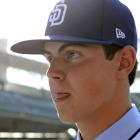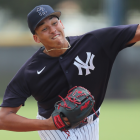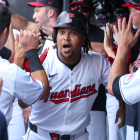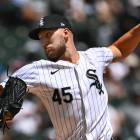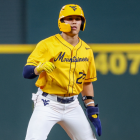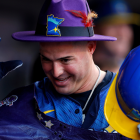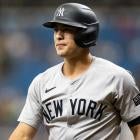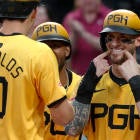With the regular season concluding, we've decided to take a look at each team's future -- not by using a crystal ball or other psychic abilities, but by evaluating their farm systems. Below you'll find our ranking of the top five prospects in the organization -- sorted by perceived future potential -- as well as five other players who fit various categories. Those categories are:
2020 contributor: A player who is likely to play a role for the big-league team next season.
Analyst's pick: A player who is a strong statistical performer and/or whose underlying measures are better than the scouting reports suggest.
Riser: A player on the way up.
Faller: A player on the way down.
One to watch: An interesting player to keep in mind (for whatever reason).
These rankings were compiled after talking with various industry sources about the systems (and players) in question. It should be acknowledged that this process is more art than science, and that there are limits to ordinal rankings. Still, it's an intuitive system, and our hope is that the write-ups will answer any questions by providing additional context and analysis of each player -- such as their pluses and minuses; the risk factors involved; and their estimated arrival date.
One last word on eligibility: we're following MLB's rookie guidelines by disqualifying any player with more than 130 big-league at-bats or 50 innings pitched.
The San Diego Padres may have graduated Fernando Tatis Jr. and Chris Paddack, among others, but they continue to boast one of the better farm systems in baseball -- and should for at least another year. Here's a look at the Padres' top prospects:
1. MacKenzie Gore, LHP
The top left-handed pitching prospect in the game, MacKenzie Gore checked off a few items from his to-do list in 2019: he crossed the 100-inning threshold for the first time; reached Double-A; and, thus, was able to refer to himself as a "Sod Poodle." It's the little things.
Gore has elicited Clayton Kershaw comparisons due to his delivery and his trademark curveball. It's probably unwise to expect anyone to match Kershaw's career, but Gore does have the chance to become a front-of-the-rotation starter thanks to his athleticism and a deep arsenal that could end up featuring four above-average pitches.
Presumably Gore will begin the season in Double-A. It's reasonable to expect him to debut at some point in 2020. It's also reasonable to expect him to team with Chris Paddack as one of the most fun tandems in baseball.
2. Taylor Trammell, OF
One of the biggest surprises at the trade deadline saw the Padres acquire Taylor Trammell as part of a three-team trade with Cleveland and the Reds. The Padres shipped out outfielder Franmil Reyes, left-handed starter Logan Allen, and infielder Victor Nova in exchange for Trammell, who has a chance to become the most valuable part of a deal that included big-league stars Trevor Bauer and Yasiel Puig.
Alas, Trammell's iffy season at Double-A didn't get better after changing teams. His average, walk rate, and strikeout rate all went in the wrong direction, and while he hit for more power, it seems a fair amount of that had to do a friendlier hitting environment. If there was one positive after the trade, it's that the Padres seem intent on letting him play center -- he has jets, but he's been projected to land in left due to a substandard throwing arm.
One source compared Trammell's likely upside to longtime Yankees outfielder Brett Gardner. For that comparison to come to fruition, Trammell may need to abandon hope of tapping into his raw power and instead focus on maximizing his contact and on-base skills. Should he make progress with whatever route he picks, he could debut early in 2020.
3. Luis Patino, RHP
Aaahh!!! A short right-handed pitching prospect.
Luis Patino is listed at 6-foot, 192 pounds, which makes it tempting to bet that his future is in the bullpen. Yet he'll pitch next season as a 20-year-old, and his combination of stuff (he has a lively above-average fastball and a suitable out pitch in his slider) and polish suggests he deserves the chance to continue starting until his body and/or his results say otherwise.
There are a few areas where Patino shows his age, beginning with his lagging changeup and extending to his workload. He's yet to throw as many as 100 innings in a season -- understandable given his youth, but also a fairly arbitrary standard that he would've topped had the Padres not shut him down in August after he developed a blister. The other aspect he needs to continue to work on is his command, and it's at least possible that he'll need to ditch the crossfire element in his delivery in favor of being on a more true line to the plate.
Yes, many pitching prospects need to work on their changeup, command, and their workloads. But most of them haven't experienced success in High-A as a 19-year-old. Patino still has a wide of range of potential outcomes -- with further development, he's a front-of-the-rotation starter; without, maybe he's just a high-leverage reliever -- and that's okay. For the time being, it's enough to label him one of the game's most interesting and exciting pitching prospects.
4. C.J. Abrams, SS
Trammell wasn't the only notable prospect the Padres added to their warchest over the summer, as they also plucked C.J. Abrams sixth in June's draft.
Abrams is a burner and was considered one of the quickest players in the draft. He's more than just a fast-moving set of long legs, as his angular 6-foot-2 frame suggests he could add weight and, perhaps, power. At minimum, he could wind up as a leadoff-caliber hitter.
Defensively, Abrams has an uncertain future. He's a shortstop for the time being, but it shouldn't come as a surprise if he's moved elsewhere -- be it second base or the outfield.
5. Xavier Edwards, MIF
The second of San Diego's two first-round picks in 2018, Xavier Edwards hit a combined .322/.375/.396 across two levels in his first full professional season.
Edwards's speed is his calling card, and he used it to swipe 34 bases on 45 tries -- or an acceptable 76 percent success rate. He doesn't offer much power -- and isn't likely to based on his frame and his swings -- yet he has a good feel for contact and puts the ball in play a lot, often to the opposite field. Scouts expect Edwards to remain an up-the-middle defender, though it's unclear if he'll stick at shortstop, slide to second base, or perhaps even move to center field.
As such, it's fair to write there's a fair amount of similarities between Edwards and Abrams. The reason Edwards is listed second is because Abrams is believed to have more power potential.
2020 contributor: Adrian Morejon, LHP
Adrian Morejon made five appearances in the majors before being shut down with a shoulder impingement in August. Staying on the mound has been a challenge for him, as he's yet to throw more than 65 innings in a season. Factor in his build -- he's strong but on the short side -- and there's a chance he winds up being pushed to the bullpen. Morejon won't turn 21 until late February, so expect the Padres to give him and his three-pitch mix another look as a starter.
Analyst's pick: Joey Cantillo, LHP
The 468th pick in the 2017 draft, left-hander Joey Cantillo had himself a breakout season in the Midwest League. In 19 starts he posted a 1.93 ERA, a 4.74 strikeout-to-walk ratio, and a 35 percent strikeout rate. Based on those numbers, you'd suspect Cantillo possesses big-time stuff -- he doesn't, even with some velocity gains. In fact, Cantillo's stuff is pedestrian, to the point that the Padres were said to be open to trading him at the deadline -- perhaps hoping to sell him at a high point to a numbers-focused team. Cantillo does have a deceptive, over-the-top delivery, but be skeptical about his results continuing to outpace his arsenal to this extent.
Riser: Luis Campusano, C
There aren't a ton of great catching prospects these days, but 21-year-old Luis Campusano put himself on the map with an impressive season in High-A. He hit .325/.396/.509 with nearly as many walks as strikeouts. That'll play. Campusano also has a strong arm and is expected to remain behind the plate, provided he continues to improve on the position's more nuanced aspects. He has a chance to crack the top five with another good year.
Faller: Buddy Reed, OF
There's nothing wrong with Buddy Reed's secondary skills. He's a near-elite runner and high-quality defender with the arm to play across the outfield as need be. Unfortunately, he remains a work-in-progress offensively, as he's a switch-hitter with a slappy swing and a proneness for striking out. Reed did pull the ball more in 2019, and his 14 home runs and .160 ISO hint at his raw pop. Just keep in mind, however, that he ranked ninth in slugging and sixth in ISO among Amarillo Sod Poodles with at least 150 plate appearances. He'll turn 25 in April.
One to watch: Ryan Weathers, LHP
The Padres drafted Ryan Weathers at No. 7 in 2018. That he's down here instead of in the top five speaks mostly to the system's high quality, and slightly to his profile. Unlike your standard prep arm drafted in the top 10, Weathers's appeal is his polish and floor -- as opposed to raw stuff and ceiling. The upshot here is a three-pitch lefty with good command who jets through the system as quickly as announcers mention his father, longtime big-league reliever David.









